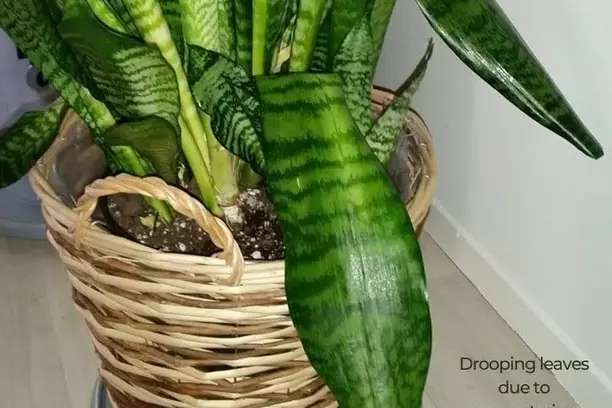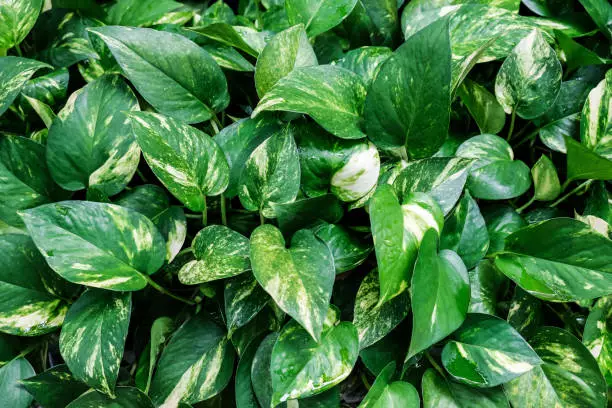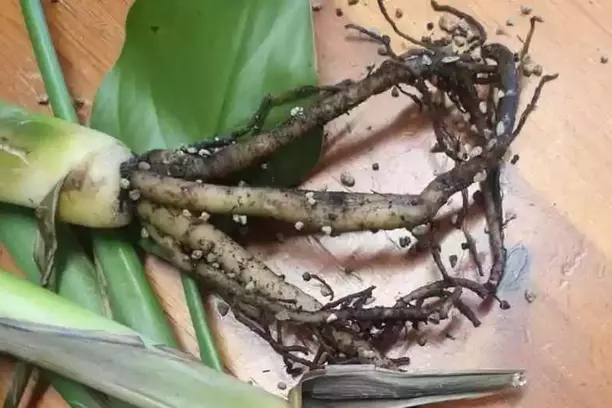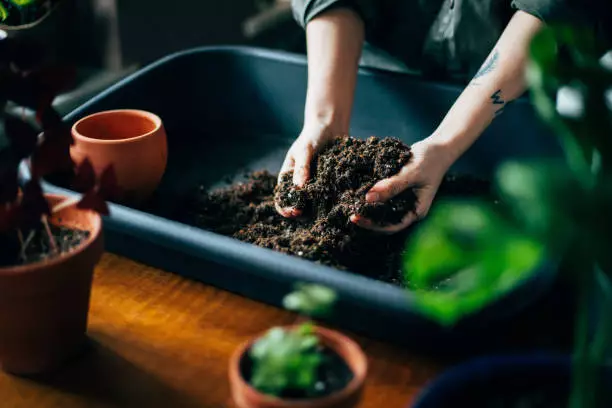Money trees are vulnerable to root rot if your watering is erratic. The plant will quickly start showing signs such as drooping, yellowing leaves, and slow growth. Rotten roots can be slimy and mushy with an unpleasant swampy smell. Such roots may also turn gray, black, brown, or purple. These signs mean the money tree is dying from too much water.
Root rot in money trees is mainly caused by overwatering. Affected roots will appear slimy with a black-brown color. To help the plant recover, remove it from the pot and cut off any rotten roots. Treat the remaining ones with a hydrogen peroxide solution then repot to revive the money tree.
Rotten roots are unable to absorb water and nutrients from the soil and if not treated on time, the fungal disease can kill the plant. Saving the plant involves cutting off the rotten trunks with a sterilized tool and replacing the potting soil plus the container. Alternatively, you can treat the plant’s roots with hydrogen peroxide.
What do healthy money tree roots look like?
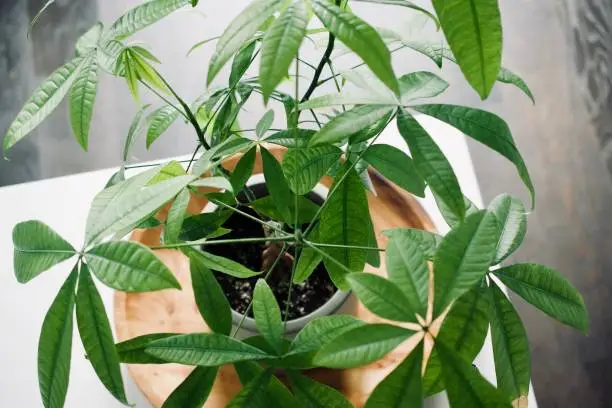
Healthy money tree roots are white, tan, light-colored, and crisp. They are also long, succulent, and numerous, holding the soil in the shape of the container. Any visible root tips should also be white. If the roots are white but look crumbly or have abnormal shapes, it may be a sign that your money plant is unhealthy.
Healthy money tree roots are firm and smell woody. If you can catch an unpleasant foul smell from the root or soil area, you must remedy the situation immediately before it gets out of control.
Signs of root rot in money trees
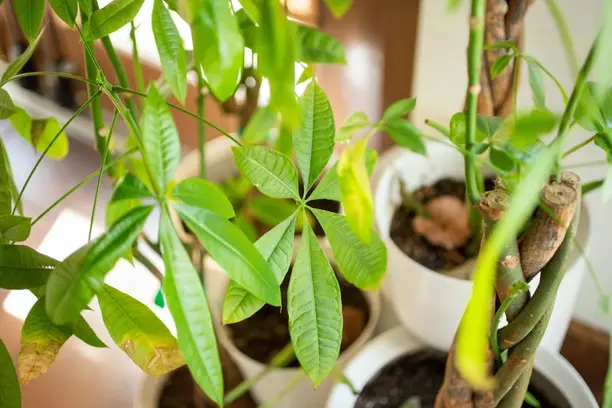
Root rot fungus in money trees can have various visible signs on the plant. The disease will discolor the tree’s leaves, and the trunks can turn mushy and soft. Overall, the beauty of the plant will gradually decline and it may eventually die if it is not fixed on time.
Here are some of the symptoms of root rot disease in money trees:
Yellow or brown leaves
Healthy money tree leaves are dark green in color. The first indicator of root rot is leaf discoloration. The money tree leaves will usually turn yellow or brown. Natural discoloration where older leaves fade and fall off happens in healthy money trees and should not be confused with the impact of overwatering.
However, when you see yellowing and browning happening to many leaves at once, including young leaves, that’s an indicator that your money tree’s roots are probably rotting.
Soft trunk
Root rot also causes soft trunks in money trees. At the base of the tree, where the trunk is in contact with the soil, you’ll notice excess water held in a swollen stem. If you pinch that area lightly, you will realize that it holds significant amounts of water and tears easily.
If that’s the case, the roots are dying from suffocation and lack of dissolved oxygen in the soil. Check the roots as early as possible to save healthy roots and remove rotten ones.
Wrinkled and wilting leaves
Wrinkled leaves are primarily associated with money trees that do not get enough water (underwatering). However, when the roots are damaged from underwatering, they may not absorb water as required. The result is wrinkling and inward curling of money tree leaves.
RELATED: HOW TO SAVE MONEY TREE LEAVES FROM CURLING
The leaves will develop spots and necrosis because the money tree cannot absorb enough water and phosphorus from the soil due to damaged roots. If left untreated, they will wilt, turn bronze, red, or purple, and die. If you are sure that the tree has been recently overwatered even though the soil looks dry, you should check for root rot.
Smelly plant tissue
When the money tree turns squishy and soft, the plant tissues in those areas begin to die and harbor bacteria. Coupled with lots of water, the areas become slimy and release a slightly sulfurous smell. It can also smell swampy and unpleasant. If large plant sections are smelly, the money tree will begin to attract mold, pests, and diseases.
Sniff your plant and notice the smell. If your money tree smells like rotten compost or sulfur, the soil must be soggy, and the root hairs might be dying out.
Stunted growth
Rotten money tree roots mean the plant cannot absorb the nutrients it requires for healthy growth. Nutrients like nitrogen, for example, promote rapid growth, and phosphorus ensures the leaves are green and healthy due to photosynthesis. When these nutrients cannot efficiently reach the plant organs where they are needed, the money tree’s growth rate declines.
When you notice a stunted plant, even with the provision of adequate fertilizer and watering, then your money tree’s roots may be rotten. However, there is nothing to worry about when the growth is slow in winter. Cooler temperatures slow down the plant’s physiological processes and could be the reason for the stunted growth.
What causes root rot in pachira aquatica
So many things can cause root rot in Pachira aquatica. In most cases, if you don’t know how to care for your money tree, you’re likely to kill it with excess water or even drought.
Here are some of the main causes of root rot fungal disease in Pachira aquatic:
- A disproportionate pot: Growing a money tree in a huge pot makes you water the plant in relation to the pot instead of the plant. In other words, you will be unconsciously overwatering the tree. Excess water retained in the pot will cause root rot and death to your money tree.
- Low temperature: Money trees do not consume much water in low temperatures due to reduced physiological processes. You must decrease your watering schedule in cold seasons like winter to reduce the likelihood of root rot.
- Overwatering: We’ve seen that overwatering causes soil sogginess, which drives out oxygen from the soil and kills young root hairs. In the absence of oxygen, bacteria take over the money tree’s roots, and they begin to rot and release a foul smell.
- Poor drainage: Poor drainage results in water accumulation in the money tree pot. The roots drown and suffocate. Since the roots can no longer sustain the money plant, the roots will rot, and the plant will die along with the roots.
- Soil pathogens: Growing money trees in soil infected with pathogens like Phytophthora, Pythium, Fusarium, and Rhizoctonia species can quickly result in root rot. Pathogens cause root rot faster when there is adequate water and temperature.
- Underwatering: Money tree roots will wither and shrink when you fail to water the plant for a while. However, if you suddenly flood it with water, the tree may get shocked, making its fragile root system susceptible to root rot.
How to treat and save the money tree
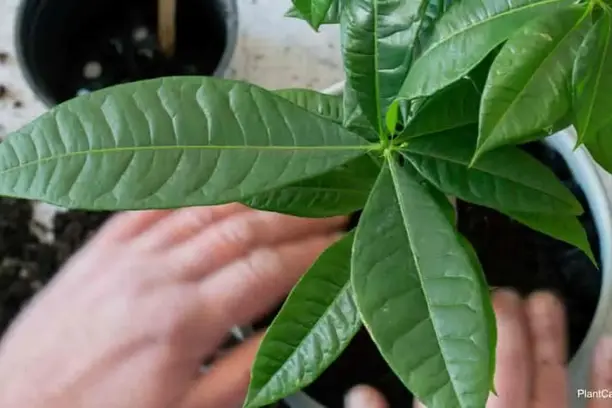
If the damage has not progressed to severe levels, you can reverse root rot and save your money tree using a few options I’ve explained below.
Here are some ways to treat and save your money tree;
1. Treat root rot with hydrogen peroxide
You can control the pathogens that cause root rot using a weak hydrogen peroxide solution.
Mix one part 3% hydrogen peroxide with two parts water. Pour the mixture into a spray bottle and spray carefully over your money tree’s root system. Hydrogen peroxide will kill the fungus that causes the roots to rot and also improve soil oxygen. Cut off any damaged roots if necessary.
If you do not have hydrogen peroxide, you can use a plant fungicide to treat the rot in your houseplants.
2. Repot your money tree using a well-draining soil mix
Repotting is one of the best fixes for money trees that are dying from overwatering. As soon as you see yellow leaves, move the plant to a spot with indirect light – or one that’s shaded – then begin the repotting process.
Using the same pot and soil may transmit root rot pathogens to your new plant. Use fresh potting soil and a clean disinfected container. I recommend a terracotta pot with a diameter that’s one inch wider than your money tree’s root mass. Most importantly, ensure the pot has drainage holes and place the pot in a saucer or pebble tray to hold the excess flow.
Pro tip: Keep in mind that repotting in direct sunlight will hurt your houseplant even more. It is best to do it in a place with low light to reduce excess water loss and the effects of potting shock.
3. Prune the rotten roots
Pruning the rotten roots involves removing the money tree from the soil and washing the roots gently with warm running water. Remember that rotten roots are any color but white and crisp. Therefore, use a sharp, sterilized pair of scissors to trim brown or black roots carefully. Be careful because the disease may spread if you leave any rotten roots untrimmed.
4. Re-propagate your dying money tree
If your plant is so damaged by the fungal disease to the extent that you cannot save any roots, the best solution to revive it is to propagate the remaining living parts. Money trees can grow by propagation.
Prepare a pot of succulents and cactus mix, perlite and pumice chips, or peat moss and horticultural sand. Make 25cm cuttings from healthy branches that have several leaf nodes.
Push the cut end of the stem into the soil mix until ⅓ of it sinks below the surface. The money tree will sprout leaves and roots in about seven days, giving you an identical yet healthy plant free from root rot.
5. Provide adequate water, light, and temperature
Finally, place your money tree in bright, indirect sunlight. Locate it where it can receive at least six hours of light a day. Also, ensure that the tree grows in temperatures between 65 and 80 degrees Fahrenheit. Water money trees only when the top one or two inches of the soil is dry, with minimum watering in winter and once a week in summer.
Combining these factors will make the money plant healthy and resistant to diseases.
